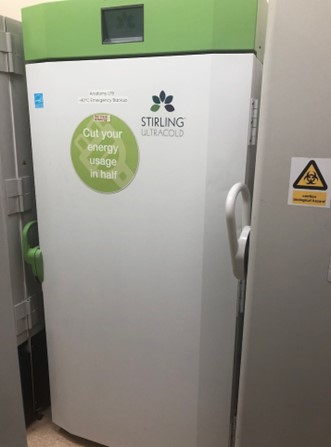At a recent research forum, the Biomedical Sciences Sustainability Group heard about a case study on ultra-low freezers, which typically operate at around -70 to -80 degrees Celsius, and how Stirling cycle freezers are changing the game. The Sustainability Group is keen to spread the word about the benefits of these freezers.
Ray O’Brien, Tumuaki | Head of Sustainability at the University’s Sustainability Office, says moves to replace older style freezers with the new Stirling freezers align with the University’s commitment to reach net carbon zero by 2030.
“We have a budget for decarbonisation, which allows us provide top-up funds when departments need to replace items such as ultra-low freezers. This means we contribute the difference in cost between a standard freezer and a Sterling cycle unit,” says Ray.
The Department of Microbiology recently purchased two Stirling freezers, and the Sustainability Office is interested in hearing from others who may be planning to replace a freezer.
The Property Services energy team has reported on the advantages of the Sterling cycle unit compared to the compressor-driven models most widely in use:
- Existing aging ultra-low freezers cost 360 per cent more to run than the most energy efficient Stirling ultra-low freezer. Even a new compressor-driven, ultra-low freezer would use 35 per cent more energy than the Stirling freezer.
- The Stirling equipment produces much less heat, meaning a reduction in cooling requirements in the room.
- The refrigerant within the Stirling units is EPA SNAP-approved 100 per cent natural, with a smaller greenhouse footprint.
Ray says that the Stirling freezers have more storage space than the older style freezers. They are also much easier to install as they can be brought into buildings via doorways and lifts, rather than having to be craned in.
More information
To find out more about the funding top-up, please contact:
Email netcarbonzero@otago.ac.nz
Case study: Anatomy a huge fan of this technology

A Stirling ultra-low freezer in the Department of Anatomy.
Carol Dunstone, Technical Manager at the Department of Anatomy says, “Anatomy were the lone owners of any Stirling freezers for many years until Microbiology joined us this year. We now have three and are in the process of adding two more.
“We love our Stirling freezers and certainly now consider them a first option when replacing or purchasing a new ultra-low freezer.”
Carol says they were first introduced to the Stirling technology via Property Services in 2016. Hans Pietsch, the then Energy Manager, asked around to find a department that might be willing to invest in one of the large Stirling freezers and run an energy trial against other technologies.
Anatomy was in the market for a new ultra-low freezer at the time, so agreed to do the trial and took possession of its first Stirling freezer in June 2017.
The first results of the energy trial were “immediately promising” and in the five to six years since then, the Stirling freezers have required virtually no maintenance other than a back-up battery replacement. By comparison, a newer compressor freezer has had problems with the compressor overheating and a noisy fan.
Carol says Anatomy uses Stirling freezers for a range of things including long term storage of research samples (DNA, cells, and tissues), as well as chemicals and kits for research such as antibodies, enzymes, ELISA kits, and animal sera for immunohistochemistry.
“The contents of a single Stirling freezer, or any ultra-low freezer, can represent thousands of hours of research effort which are often invaluable and irreplaceable, which is why we invest in good technology.”
“I can happily confirm that the Stirling freezers are quieter, produce less heat and use less energy than a conventional compressor-driven freezer and have virtually no maintenance costs.”
Kōrero by Sally Knox, Communications Adviser, School of Biomedical Sciences